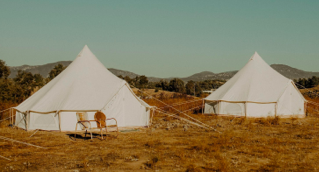Menu
-
- Shop
- Glamping Tents
- Wall Tents
- Canvas Tent
- Bell Tents
- Festival Tents
- Hunting Tents
- Yurt Tents
- Family Tents
- Stargazing Tent
- Cabin Tents
- Camping Gifts
- Overland Tents
- Tent Stoves
- 4 Person Tents
- 6 Person Tents
- 8 Person Tents
- 12 Person Tents
- Canvas Bags
- Camp Gears
- Camping Chairs
- Shade Canopy Tents
- Camping Fans
- Resources
- About
- Contact Us
- Reviews
-
- Login

Free Shipping

Pay No Sales Tax
30-Month Warranty
Tents
Shop


The LiT List
Glamping & Camping Ideas + Resources
What Are the Best Tents for Long-Term Camping?
6 min read
Are those weekend camping trips just not cutting it? Crave a longer excursion in the wilderness and want to settle in for a while? Whether it’s for a summer camp getaway or a hunting trip at your family deer camp, long-term camping trips bring a certain level of escapism that Life inTents understands all too well.
But just what are the best tents for long-term camping? In this guide, we break down what makes a tent good for long-term camping trips and show you some of the best tent styles for the job.
Features of Long-Term Camping Tents

Before we dive into the best tents for long-term camping, it helps to understand what makes them that way. To sum it up, long-term camping tents should offer many versatile features and be constructed of quality materials intended to last.
What do we mean? Here’s a breakdown of some features to consider before choosing a tent for your long-term camping adventures.
Multi-Season Use
Whether your long-term camping plans are to pitch a tent in winter or summer, you’ll need a tent capable of handling more than one season. A four-season tent offers insulative properties and materials that can stand up to winter conditions and ensure you stay warm through cold nights, But at minimum, a three-season tent for long-term camping is a must.
Weather Resistance
The best tents for long-term camping are weather-resistant. That means pouring rain, high winds, and more. Tents intended for camping for long periods of time should have a high waterproof rating and a sturdy steel frame to resist storm gusts and even heavy snowfall.
Durable Materials
Long-term camping tents are designed of durable fabrics that can withstand the elements for greater lengths of time. Heavy-duty nylon or canvas is ideal. Canvas is a perfect material because it offers breathability.
The main material of your tent should also be held together with reinforced seams and corners to prevent leaks and tears, and sturdy pole hardware. Even the zippers, which you’ll use over and over again, should be solidly made.
Ventilation
Speaking of zippers, adjustable vents and bug-blocking mesh panel windows are critical. These features will reduce condensation and offer airflow to the interior, making your living space comfortable. It also minimizes the chance of mildew, along with proper care and cleaning.
Layout and Space
Since you’ll probably stay in this tent longer than a week, ensure there’s adequate space for everyone. Long-term camping means spending lots of time outdoors, but you still need enough elbow room for people and storage for gear.
Whether you want an open yet adaptable interior or need to break the floor plan into sections, there’s a tent for both preferences. You can often find long-term camping tents with privacy dividers and even separate rooms or vestibules. Also, a taller tent with a stand-up height interior is a must!
Organization
One way to make the most of your camping tent’s space is to keep it organized and tidy. Some long-term camping tents offer extra features like built-in storage pockets for all those bits of gear you have lying around. Structural poles can even offer hooks for heavier gear like lantern lights.
Wood Stove Compatibility
If you plan to do some winter camping, a wood stove is a must. But for that, you need a long-term camping tent designed to take on a stove. The best tent for this is one with a flame-retardant coating, which is typically found on cotton or poly-cotton canvas.
Additional fire protection includes a protective exit hole for the stove pipe and a stove jack for the flue exit point. You could also add a flashing kit yourself.
Rainfly and Sun Shade
Another nice touch to a long-term camping tent is the ability to remove or add protective accessories and elements. For example, a removable rainfly or sunshade offers a handy tool for some tents, creating extra ventilation and breathability.
A sunshade to the tent’s side can add extra living space and a protective shelter during rain.
Portability and Ease of Setup
You probably only intend to pitch and break down your long-term camping tents once for your trip. However, it’s still beneficial to make sure it’s easy to set up with one or two people.
Some features that make pitching a tent go smoother and swifter? Coded poles, easy assembly instructions, lighter materials and, once it’s all broken down again, a case or duffel bag to transport and store it.
Like many things, the best long-term camping tent might come down to your specific needs (and wants). But the breakdown above should give you some ideas on tent features to look for, what they offer, and what to consider as you settle into the wilderness.
The Best Long-Term Camping Tent Styles
Now that you understand what makes a tent equipped to handle long-term camping excursions, let’s talk about some of the best long-term camping tents you’ll find out there.
With so many options available, it can be tough to make a choice, especially one suitable for your camping needs. So here’s what you can expect from each:
Canvas Bell Tents
Great bell tents are made of breathable yet insulative canvas (or poly-canvas). Life inTents bell tents are specifically designed with a water and mold-resistant DoekTec Canvas (11.5 oz / 360 gms, the heaviest on the market), so you can rest assured it’s durable enough to withstand Mother Nature. And even though canvas outweighs nylon, the heavier material is what makes it ideal for long-term camping.
Even so, bell tents can be pitched in 20 minutes or less. Designed with a galvanized steel center pole and door frame poles, our tents can take on all kinds of weather. Our tents are also structured with an aluminum outer wall pole system, providing tautness to the roof eaves.
Excellent for long-term shelters, bell tents are wood stove compatible and come in a wide range of features mentioned above, as well as size and style options. All that and beautiful enough to pitch in your backyard for a multi-purpose living space all year round!
Dome Tents or Geodesic Tents

Dome style tents, like Geodesic tents, are also one of the best tents for long-term camping shelters. They offer spacious interiors, an easy setup, and are generally lighter in weight than canvas-style long-term camping tents.
That being said, they’re often made of polyester or nylon, which has its pros and cons. The advantage is the lightweight material and water and UV-resistant. The disadvantage is that this makes it somewhat incompatible with stoves.
Dome and geodesic tents also boast panoramic windows and skylights, which is wonderful for personal backyard spaces. Not so much when you need privacy in the woods.
Cabin Tents or Lodge Tents
If you want a tent interior with “rooms,” a cabin tent is a nice option for longer camping trips. Also called a wall tent, they can be pretty spacious, yet offer vertical walls to designate sleeping, cooking, and living spaces.
You can find cabin styles made of canvas and nylon, but again, stick to canvas for a long-term camping tent. Especially if the cabin tent has the option for a wood stove!
Cabin lodge tents are great for larger groups and families. They work well for families with teens desperate for their own space. However, bell tents also offer extra privacy dividers (just something to consider).
Roof-top Tents

Long-term camping doesn’t always mean staying in one place. For campers on the move, a rooftop tent is a fantastic option. It’s extra ideal for overlanders.
One caveat is that they rest on top of your car. So you need the right vehicle, and you need to be okay with limited space. Roof tents are typically designed as two-person or four-person tents, so not roomy enough for larger groups or families.
And since you use your vehicle to and for, you’ll have to repeatedly break down and set up, but hey, it means you can experience several new destinations. Roof tents aren’t for everyone, but they’re the perfect long-term camping solution for those with itchy feet.
Maintaining a Long-Term Camping Tent
Pitching a tent outside for extended periods requires a certain level of maintenance. While all tents should be cleaned and cared for, this goes double for long-term camping tents. This is why it’s so imperative to choose a durable tent for these occasions.
Once you choose the best tent for long-term camping, provide it the maintenance it needs and it can last you a lifetime! Discover how to maintain and clean a bell tent during and between each adventure.
Related Resources

THE LIT LIST 4 min read
Can Glamping Businesses Survive a Recession?
Examining the Resilience of Luxury Camping Businesses Glamping, the luxurious cousin of traditional
THE LIT LIST 5 min read
Duffel Bag vs. Suitcase: Which is Right For You?
Headed on a trip? Not sure if you should pack a duffel bag or a suitcase? The choice might seem diffDuffel bag vs. suitcase: Compare the pros and cons of each to decide the ideal travel companion for you.
Popular Blogs
Camping Gift Ideas for People Who Have Everything
The Best Portable Tent Heaters - Ways To Heat A Canvas Tent
Glamping in Northern California: 8 Luxury Sites
Waterproofing A Canvas Tent - Retreating Canvas
33 Camping Quotes to Inspire Your Next Adventure
What Is Glamping? Origins, Definition, Destinations & More
10 Tips for Staying Warm While Winter Camping
How to Maintain and Clean a Bell Tent
Essential Family Camping Checklist: What to Pack [PRINTABLE]
Backyard Glamping Checklist for an Unforgettable DIY Glampsite
Popular Products
Subscribe
Sign up to get the latest on sales, new releases and tips
BECOME AN INSIDER
We’ll periodically share inspiration, bell tent releases, special offers, and event notifications with ya.


